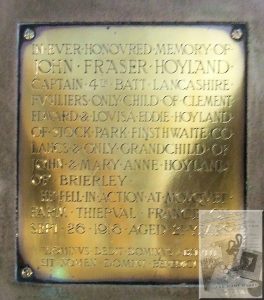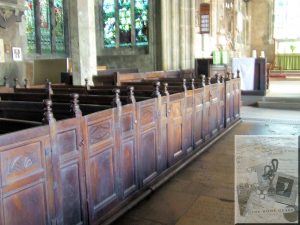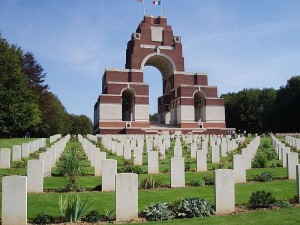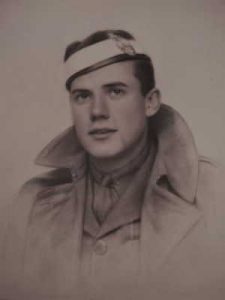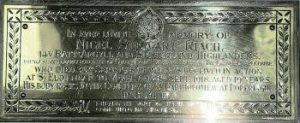Ernest W. Litherland, The Grange, Monckton.
John Edward Litherland, born in Darton, was married to Edith Mary nee Braithwaite who he had married in the summer of 1889.
Their first child Ernest William Litherland was registered in the same quarter the following year and baptised in the Parish Church of Darton on the 13th of July. By the time the census was taken in 1901 the family had grown a little – John was by now 37 years of age, his wife was 30. Their children ranged from Ernest aged 10 to George just two years old – with Muriel aged nine and Cyril aged seven, filling the gaps in between.
In the following ten years, the family seems to have grown somewhat and developed a little mystery! I love a mystery, a problem, can I sort this one out?
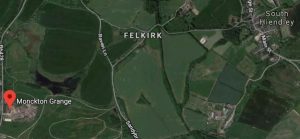
Google map showing the proximity of Felkirk to The Grange, Monckton.
In the census taken in 1901, there were four children in the family, but 1911 census as well as being the accepted children that follow George, there seems to be one that fits in between Cyril and George – where was that child in the previous census? Was she living with grandparents or staying with friends? Before I go off and look for her I’ll tell you who was in the house in at Monckton in 1911 – Jno Edward Litherland was still head of the house, followed by his wife, Edith. She was followed by Ernest, 20; Muriel, 19; Cyril, 17; Francis Jane, 16 (our new inclusion); George Thomas, 12 and followed by Richard Douglas aged 6. There was also a visitor and his wife, George Edwin Hoey and Ann. George was an Accountant. The family were looked after by one servant, 23-year-old Susannah Moore from Royston. Life must have been good for the family as their home in Monckton, was called The Grange – a rather nice Gentleman’s residence consisting of two big receptions rooms, four bedrooms, attic rooms, approx. three acres of land and various outbuildings.
Where are you, Frances? As Frances was born in c1895 it seems obvious to look for her in the 1901 census. After a few minutes of looking through the transcriptions, there she was! Frances was living in the house of widow, Thomas Braithwaite, aged 52 from Darton but living in Selby and employed as a Surveyor Highways. Remember the surname Braithwaite, well it looks like Frances was living with her uncle and three cousins – that problem is solved, but why was she there? That one I don’t know the answer to!
Ernest is the main focus of this blog, so let me tell you what happened next. Ernest, along with his younger brother Cyril, was employed as Clerk’s at a local colliery, probably, the same one his father was Commercial Manager at.
The war, The Great War as it became known, the war to end all wars, well, they did say that at the time, but we all know it didn’t. Ernest joined the army in 1916 – the 3rd of August 1916, he became part of the Royal Flying Corps., with the service number 42446 and rank of a driver in the 27 KBS (Kite Balloon Section). On the 1st of April, Ernest became part of the RAF (Royal Air Force), after its formation that same year. A promotion followed two months later when he was given the rank of Air Mechanic 2nd Class.
Ernest was 5 ft 5¾ in tall with a chest of 32 inches. His hair or eye colouring is not noted on his Airman’s Record, neither is the colour of his complexion – would you or I recognise him walking down the street, possibly not but sometimes even the smallest bit of information tells so much.
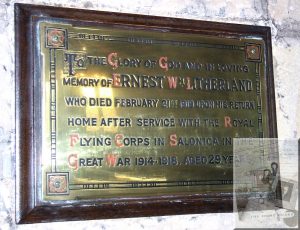
Ernest Litherland memorial in Felkirk church © C Sklinar 2018
With Ernest being part of the Kite Balloon Section, was he serving in Belgium, France or a little farther afield? Yes, he served in Salonika. Anyway, the good news is that Ernest survived his service for the Duration of the War’, but, sadly, while on demobilisation furlough he died from malaria fever on the 22nd of February 1919. How devastating for his family, to have him be home, ready to be demobbed and then he died, How many other families
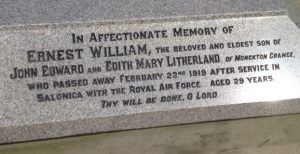
Ernest’s headstone in Felkirk Church via Find a Grave
would have gone through similar torment?
Ernest was laid to rest on the 26th of February, in the churchyard in the small hamlet of Felkirk, beneath a family headstone, bearing the inscription ‘In Affectionate Memory of Ernest William, beloved and eldest son of John Edward and Edith Mary Litherland of Monckton Grange, who passed away February 22nd 1919 after service in Salonica with the Royal Air Force. Aged 29 years. Thy Will Be Done, O Lord’, only a short way away from his home, The Grange.
Probate for Ernest was granted in London and the sum of £579 5s 11d granted to his brother Cyril, who was now working as a Colliery Salesman.
Money from the military, £22 4s 7d, including a War Gratuity of £14 10s, was paid by draft to his brother Cyril in March 1920.
Ernest’s family were eligible for his medals, the British and Victory Medals – only those two as he enlisted after 1915, which were dispatched to the family in September of 1921.
Further sadness was to come to the family in 1926 when John Edward Litherland died aged 61, followed by Edith Mary in 1932, aged 62.
Earlier there was a mention of members of the Hoey family living with the Litherland’s in 1911. Who were they? Well, it appears the Hoey’s were related as John Edwards mother was a Hoey, another question answered.
There is another memorial plaque in Felkirk church, but that will have to wait for another time.
